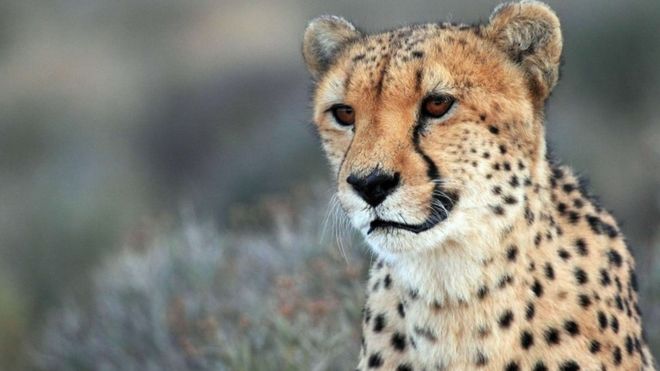 |
| Cheetah |
The
cheetah once ranged from the vast windswept plains of
Africa to the harsh and arid desert landscapes of
Arabia,
Iran and neighboring countries, and
India. In its historic Asian homelands, this majestic cat was kept as a companion of the royalty who used it to hunt fast
game. But as time passed, the cheetah began to vanish into extinction due to wide-scale hunting throughout the regions of
Western and
southern Asia leaving only small populations confined to Iran. In India, the cheetah had become extinct since 1947. But now, after seventy years of extinction, the cat might be on the path of making a comeback. This was seen in recent news, when, the
Supreme Court of India announced that Africa's cheetahs could be
introduced in a "carefully chosen location." The court further added that the cheetah would have to be introduced on an experimental basis to see if it can adapt to India's conditions. The decision was lauded by former
environment minister of India Jairam Ramesh, who had launched the movement a decade ago.
 |
| Jairam Ramesh's response to Supreme Court's decision of reintroducing cheetahs in India. |
For more than ten years, cheetah experts, wildlife officials, and
conservationists from all around the world had discussed the reintroduction of the cheetah to India. Although they agreed that there was a strong case for it, leading conservationists were afraid that in its hurry to bring the cheetah back, India would end up housing the cats in
semi-captive conditions in secured open-air zoos instead of letting them live free. They further added that possible cheetah populations cannot be established without the restoration of
prey base and
habitat, and the high possibilities of a
man-animal conflict. They even pointed to India's inconsistent record of reintroducing animals in the wild. One such example was the
reintroduction of Asiatic lions in
Chandra Prabha Wildlife Sanctuary in northern
Uttar Pradesh during the late 1950s. Although the experiment was successful with lion numbers increasing from three to eleven in 1969, the selected area was not large enough and the animals subsequently disappeared. However, conservationists who had led the cheetah reintroduction initiative insisted that these doubts are baseless and stated that a decision will only take place after the chosen sites are fully analyzed for prey, habitat, and possibility of man-animal conflict.
_05.jpg) |
| Asiatic cheetah |
I really admire this decision made by the Supreme Court of India. It clearly implies that in order to reintroduce an animal into the wild, the first step would be carry out experimental trials to see how well the animal can adapt to a new environment. In addition to that, it is equally crucial to thoroughly examine a potential release site for factors such as habitat and prey base, and the possibility of human-wildlife conflict. In that regard, here are some issues that any wildlife enthusiast would be interested in knowing to gauge the success of this experiment:
- How many African cheetahs will be reintroduced in India on experimental basis?
- Which sites have been selected for the reintroduction effort?
- How will the cheetahs be monitored during the experiment? Radio collars?
- What techniques would be implemented in determining the area size of the release site, prey base, and the potential of human-wildlife conflict?
- What native wildlife will the cheetahs be sharing their habitat with?
- How will the cheetahs be protected from poachers and other anthropogenic threats?
- Which agencies will be involved in conducting this experimental introduction and overseeing it?
- Will this project have public support?
Since Africa's cheetahs number around 7,100 animals in the world, they have been chosen as likely candidates for India's cheetah reintroduction project.
Asiatic cheetahs, which were once found in India and Western Asia, number only about fifty animals; all residing in Iran. When India asked Iran to lend some of its cheetahs as part of the reintroduction effort, the answer was "no" and now since Iran's cheetah numbers are critically low, it is best not to risk bringing any cheetahs to India from Iran. I think it is very important that the above questions should be addressed in order to give the global community some idea on how India's cheetah reintroduction project is being executed. This way everyone would know about the cheetah reintroduction experiment is progressing. But overall, this initiative sounds very good for the Indian wildlife in general and "Indianized" cheetahs in particular.

_05.jpg)

